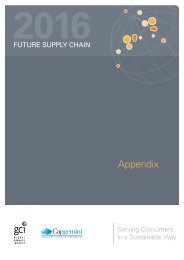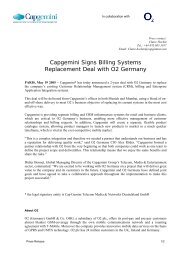You also want an ePaper? Increase the reach of your titles
YUMPU automatically turns print PDFs into web optimized ePapers that Google loves.
this trend is set to increase in the future, <strong>Capgemini</strong> has already<br />
defined and implemented an overall policy to minimize exposure<br />
to exchange rates and manage the resulting risk, particularly<br />
through regular hedging of intercompany flows. These hedges<br />
mainly take the form of forward purchases and sales of currencies<br />
(see Note 18.B).<br />
8.2.6 Financial instruments<br />
Financial instruments are used to hedge in particular interest rate<br />
and currency risks. All hedging positions relate to existing assets<br />
or liabilities and/or operating or financial transactions. Gains and<br />
losses on financial instruments designated as hedges are recognized<br />
on a symmetrical basis with the loss or gain on the hedged items.<br />
The fair value of financial instruments is estimated based on market<br />
prices or data supplied by bank counterparties.<br />
8.2.7 Employee-related liabilities<br />
The present value of pension obligations under funded defined<br />
benefit plans (see Note 19.I), calculated on the basis of actuarial<br />
assumptions, is subject to a risk of volatility. A 0.5% change<br />
in the discount rate used will trigger a corresponding change<br />
in the present value of the liability of approximately 10%. If<br />
trends concerning longer life expectancy at retirement – which<br />
are gradually being reflected in actuarial mortality tables – are<br />
confirmed in the future, the Group’s post-employment benefit<br />
liability may increase.<br />
8.3 Legal risks<br />
The Group’s activities are not regulated and consequently do not<br />
require any specific legal, administrative or regulatory authorization.<br />
In the case of some services, such as outsourcing or specific projects<br />
carried out for clients who are subject to specific conditions<br />
or regulations, the Group itself may be required to comply with<br />
contractual obligations related to such regulations.<br />
The sheer diversity of local legislation and regulations exposes<br />
the Group to a risk of infringement of such legislation and<br />
regulations by under-informed employees, especially those<br />
working in countries that have a different culture to their own.<br />
Legal precautions taken by the Group, particularly those of a<br />
contractual nature, can never provide an absolute guarantee<br />
against such risks.<br />
The Group is not aware of any litigation that is liable to have, or<br />
has recently had, a material impact on its operations, financial<br />
position or future prospects, other than those recognized in<br />
the consolidated financial statements or disclosed in the notes<br />
thereto (see Note 20 – “Current and non-current provisions” and<br />
Note 28 – “Subsequent events”). There are no governmental,<br />
court, or arbitration proceedings, including any proceeding of<br />
which we have knowledge, pending or threatened, that might<br />
have, or has had any material effect on the financial condition<br />
or profitability of the Company and/or the Group during the<br />
last twelve months.<br />
8.4 Risks related to operations<br />
<strong>Capgemini</strong> is a service provider, and as such, the main risks to<br />
which the Group is exposed are (i) failure to deliver the services<br />
to which it has committed, or (ii) failure to deliver services within<br />
the contractual time-frame and to the required level of quality.<br />
Risks concerning project execution<br />
Contracts are subject to a formal approval procedure prior to signature,<br />
involving a legal review and an assessment of the risks relating<br />
to the project and to the terms of execution. The authority level at<br />
which the contract is approved depends on the size, complexity<br />
and risk profile of the project. The Group Review Board examines<br />
the projects with the most substantial commercial opportunities or<br />
specific risk exposures, as well as proposals for strategic alliances.<br />
<strong>Capgemini</strong> has developed a unified set of methods known as the<br />
“Deliver” methodology to ensure that all client projects are executed<br />
to the highest standards. Project managers are given specific<br />
training to develop their skills and acquire the appropriate level of<br />
certification for the complexity of projects under their charge. The<br />
Group also has a pro-active policy of seeking external certification<br />
(CMM, ISO, etc.) for its production sites.<br />
Contract execution is monitored using Group-defined management<br />
and control procedures, and complex projects are subject to dedicated<br />
control processes. The internal audit function checks that project<br />
management and control procedures are being properly applied.<br />
Expert teams may also intervene at the request of the Group’s Production<br />
and Quality department to investigate projects that have a<br />
high risk profile or that are experiencing difficulties.<br />
In spite of the formal approval procedure for all client project<br />
commitments undertaken by the Group, in some cases, difficulties<br />
with respect to project execution or project costs may have been<br />
underestimated at the outset. This may result in cost overruns not<br />
covered by additional revenues, especially in the case of fixedprice<br />
contracts, or reduced revenues without any corresponding<br />
reduction in expense in the case of certain outsourcing contracts<br />
where there is a commitment to provide a certain level of service.<br />
The Group may provide a performance and/or a financial guarantee<br />
for certain large contracts (see Note 25.C).<br />
In spite of the rigorous control procedures that the Group applies<br />
in the project execution phase, it is impossible to guarantee that<br />
all risks have been contained and eliminated. In particular, human<br />
error, omissions, and infringement of internal or external regulations<br />
or legislation that is not or could not be identified in time,<br />
may cause damage for which the Company is held liable and/or<br />
may tarnish its reputation.<br />
ANNUAL REPORT 2006 <strong>Capgemini</strong><br />
31















